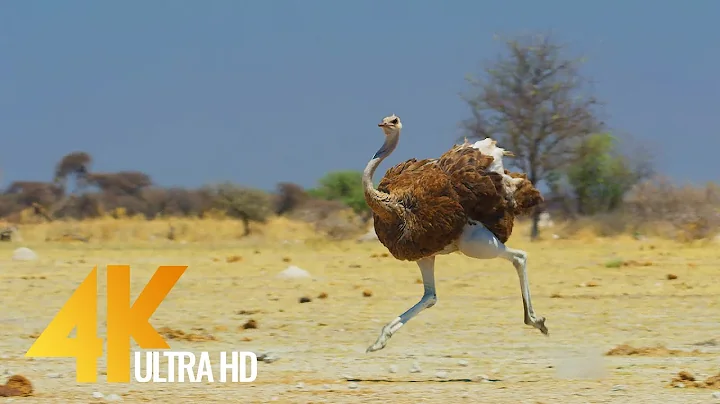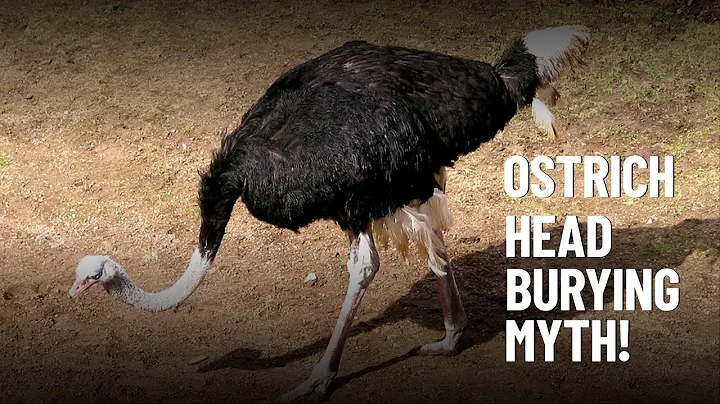Ostrich
Contrary to popular belief, ostriches never bury their heads in the sand. In fact, when threatened, these large, flightless birds invariably rely on exactly the opposite strategy, using their long legs to escape approaching danger. The honor of "world's largest bird" belongs to the ostrich.
Ostrich is widely distributed in flat, open areas of Africa with little rainfall. There are four significantly different subspecies: the North African ostrich, pink-necked, inhabits the southern part of the Sahara; the Somali ostrich, green-necked, lives in the "Horn of Africa" (Northeast Africa); the Masai ostrich, adjacent to the former, pink-necked ostrich The blue-necked ostrich lives in East Africa; the South African ostrich, green-necked, lives south of the Zambezi River . The Arabian Ostrich has been extinct since the mid-20th century.

Through evolution, ostriches have developed an effective early warning system: a long, flexible neck and large, keen eyes. This allows them to detect approaching danger in time and take quick action to escape.
Tall and flightless
Form and function
The feathers of the ostrich are soft and have no feathers. The male bird's shiny black body feathers are in sharp contrast with the long white "flight" feathers (primary "flight" feathers) on both sides of it, which makes it look extremely eye-catching and can be seen from a long distance during the day. arrive. Females and young birds are brown or gray-brown, and this color provides good concealment. The newly hatched chicks are light yellowish brown with dark brown spots and a small handful of bristles on the back, similar to hedgehog . The ostrich's neck is very long and extremely flexible. The head is small, and the unspecialized beak can be opened wide. The eyes are very large and have keen vision. The legs are naked, long and strong. There are only two toes on each foot. It has powerful front kicks and can run at speeds of up to 50 kilometers per hour. It is a tireless walking bird. Because of their long strides, long necks, and accurate pecking, ostriches can very efficiently find high-quality food that is sparsely distributed in their habitats. They feed on a variety of nutritious buds, leaves, flowers, fruits and seeds. This foraging is more like herbivorous ungulates than birds. After the ostrich eats many times, the food fills up the esophagus, and then slowly slides down the neck like a big ball (i.e., "food bolus"). Since the food bolus is nearly 200 ml, the skin of the neck will tighten during the sliding process. The gizzard of an ostrich can hold at least 1,300 grams of food, 45% of which may be sand or stones to help grind indigestible substances. Ostriches usually forage in small groups. At this time, they are very vulnerable to attack, so they will raise their heads from time to time to scan for predators. The main predators are lions, and occasionally jaguars and cheetahs. .

A group of ostriches quickly crossed Namibia , which is almost a silver-white Etosha salt marsh. For ostriches, the ability to run fast is crucial to surviving on a continent teeming with agile predators.
Looking after "other people's babies"
Biology of reproduction
The breeding period of ostriches varies by region. In East Africa, they breed mainly during the dry season. The male ostrich digs several shallow pits in his territory (its territory ranges from 2 square kilometers to 20 square kilometers, depending on the food fertility of the area), and the female ostrich (the "master" bird) and The male ostrich maintains a loose mate relationship and occupies a home of 26 square kilometers. The female ostrich chooses one of the pits and lays up to 12 eggs, one every other day. There will be 6 or more female ostriches ("secondary" females) that lay eggs in the same nest, but then leave after laying the eggs. These secondary females may also lay eggs in other nests within the territory. In the following days, the female and the male share the tasks of watching the nest and incubating the eggs. The female is responsible for the daytime. The breeding period of the male ostrich varies depending on the region. In East Africa, they mainly breed during the dry season.The male ostrich digs several shallow pits in his territory (its territory ranges from 2 square kilometers to 20 square kilometers, depending on the food fertility of the area), and the female ostrich (the "master" bird) and The male ostrich maintains a loose mate relationship and occupies a home of 26 square kilometers. The female ostrich chooses one of the pits and lays up to 12 eggs, one every other day.

There will be 6 or more female ostriches ("secondary" females) laying eggs in the same nest, but they will leave after laying the eggs. These secondary females may also lay eggs in other nests within the territory. In the following days, the female bird and the male bird share the tasks of watching the nest and incubating the eggs. The female bird is responsible for the day and the male bird is responsible for the night. Unguarded nests are clearly visible from the air, making them vulnerable to attacks by white vultures, which drop rocks to break the huge ostrich eggs with shells up to 2 mm thick. And even guarded nests are threatened by coyotes and jackals. As a result, nest attrition rates are very high: less than 10% of nests survive the approximately 3 weeks of laying and 6 weeks of incubation. Ostrich chicks are well developed at birth (i.e. precocious). Both the male and female birds accompany the chicks, protecting them from a variety of raptors and ground predators. Chicks from several different nests usually form a large flock, escorted by one or two adults. Only about 15% of chicks survive past the age of 1 year, when their bodies are fully developed. Females are ready for breeding when they are 2 years old. Males begin to grow feathers when they are 2 years old and can breed when they are 3 to 4 years old. Ostriches can live to be over 40 years old.

Conservation and Environment
Ostrich feathers have long been used as ornaments. In ancient Egypt , symmetrically placed ostrich feathers were a symbol of justice, while the ostrich brain was considered a delicacy. Today in Africa, ostrich eggshell fragments are still used to decorate necklaces and belts; in some places, intact eggshells are believed to have some magical power and can protect houses and churches from lightning strikes. In contrast, a more secular practice, like that of the Khoikhoi people of southwestern Africa, uses empty eggshells as vessels for water.
The dense presence of predators and frequent human hunting activities make it difficult to protect ostrich nests. It was the irresponsible hunting of humans that led to the extinction of the Arabian ostrich, which once existed in large numbers. Ostrich populations are declining as humans increasingly invade their habitats, but they are not yet a serious threat to the species. In addition, there are many ostriches living on the farm. People raise them for their feathers and meat. In addition, the soft ostrich skin is suitable for high-quality leather.

Knowledge Archives
Ostrich
Order Ostrich order
Family Ostrichidae
There are 4 subspecies of Masai ostrich, North African ostrich, Somali ostrich, and South African ostrich. Distribution of
in Africa (previously also the Arabian Peninsula).
Habitat Semi-desert and savanna.
body shape: about 2.5 meters tall and weighing about 115 kilograms. The male bird is slightly larger than the female bird.
body plumage: The male bird has black body feathers with white primary flight feathers and tail feathers. One subspecies has light yellow body feathers; the female bird has gray-brown body feathers. Neck and legs are bare. The skin of male birds can be cyan or pink depending on the subspecies, while the skin of female birds is light gray with a pinkish tint.
chirp Loud hissing and deep roaring.
nest Shallow pit on the ground.
Eggs: The number of eggs in the clutch is 10 to 40; they are shiny and milky white; they weigh 1.1 to 1.9 kilograms. The incubation period is 42 days.
Food Grass, seeds, fruits, leaves, flowers.
Conservation status The ostrich in Africa is currently not threatened. The Arabian ostrich was hunted to extinction, with the last record in 1966.

!["What Would Cause a Bird to Be Flightless" [Live Highlight] - DayDayNews](https://i.ytimg.com/vi/9ToDSVTO6KI/hq720.jpg?sqp=-oaymwEcCNAFEJQDSFXyq4qpAw4IARUAAIhCGAFwAcABBg==&rs=AOn4CLCXNhlK4QLo9iA3D5a7kpye8FozMQ)
!["What Would Cause a Bird to Be Flightless" [Live Highlight] - DayDayNews](https://cdn-dd.daydaynews.cc/img/play.svg)



















